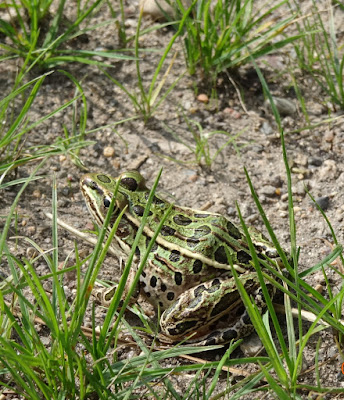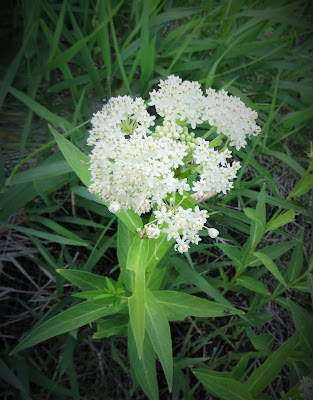Evidently there are still damselflies or dragonflies among the reeds and grasses on the shore. This sparrow scored one while hopping in the shallow water of the pond.
11/02/2020
10/31/2020
surviving below freezing - turtles
Since we had several cold days and nights already, Painted Turtles Chrysemys picta who live in the pond are getting ready for winter. Lacking summer heat, this one was wandering very very slowly for a food item or a place to settle. Turtles will spend the next several months in frigid pond water below the frozen ice, with their metabolism and their heart rate slowed way down. They can absorb oxygen from the water through vascularized areas in their mouth, throat, and anus (cloacal respiration). But using oxygen produces lactic acid in their body, which the turtle counteracts with minerals released from its shell and bones. Painted Turtles do not eat during this time, but they do remain alert, especially to light from above. In Spring, when the hours of daylight increase, they will respond.
10/05/2020
floating pondweed
The floating leaves of Pondweed are fading at the end of summer. And the leaves of the nearby trees fall in the water, drift with the breeze, and catch on the Pondweed. They look golden in the sunlight, brighten the pond, and complement the wildflowers surrounding the water.
Floating Pondweed Potemogeton natans has two kinds of leaves; floating and submerged. The shiny leathery floating leaves are opaque, and support the whole plant which is rooted in the mud below. The submerged leaves are thin, transparent, and move with the water. In summer these plants provide habitats for many tiny aquatic invertebrates. These in turn are used as food by frogs, snakes, turtles, and ducks who feed here. After these plants die, their decomposition by bacteria and fungi provides food in turn for the aquatic invertebrates. The Pondweed survives winter with rhizomes buried in the mud at the bottom.
yellow loosestrife
9/27/2020
muskrat tail
The muskrats who live here were gathering breakfast this morning in the pond. One, with tail held high, munched aquatic plants growing to just below the water surface. Their tails are 7 to 11 inches long, covered in scales rather than fur, and flattened vertically (side-to-side) to serve as a rudder in swimming.
9/26/2020
September wildflowers
9/20/2020
leopard frog
Leopard Frogs Lithobates pipiens who live in our pond may travel one or two miles from water in the summer. You might hear them make a long, deep 'snore' noise lasting several seconds ending with a chuck-chuck-chuck. In the fall, Leopard Frogs come back to their pond. We saw this one hopping across the sandy shore. They spend the cold winter in the water, burrowed into the mud, hibernating with their metabolism slowed.
9/15/2020
9/12/2020
8/10/2020
Monkey Flower
Blooming now -- small lilac-purple flowers at the very edge of the pond. Some native plants around the pond, like these, are not noticeable until you get close. Monkey Flower Mimulus ringens. The name comes from the Latin diminutive of mimus meaning "a mimic" or little monkey. The flowers are like tiny snapdragons, less than one inch long. Bumblebees are important native pollinators for this species. Monkey Flower is a native plant, naturalized along the pond's margin.
8/06/2020
Monarch butterfly caterpillars

 |
7/20/2020
muskrat mid-summer meals

 Now that the clover growing near the pond is on the wane, the muskrats are finding other plants to eat.
Now that the clover growing near the pond is on the wane, the muskrats are finding other plants to eat.Here, the muskrats eat pondweed, rushes, grasses, sedges, and other aquatic vegetation. We do not often see them feeding right where they find food. They usually cut and drag plants to a feeding spot near one of their travel paths. There, they can eat without worrying about predators.
Muskrats consume about one-third of their weight each day. That's a lot of greens!
7/19/2020
pond morning sounds
Then you notice the bullfrogs calling. It is said they can be heard up to a quarter mile away. They are vociferous from early June through July.
7/15/2020
green heron - frog for lunch
green heron hunting

Green Herons look small and stocky (pictured here), until one is hunting for a meal on the shore of the pond. Then they stretch their neck full length to reach the prey.
They hang out in small freshwater wetlands near ponds and streams lined with thick vegetation. All the better to hide in while hunting.
Herons are opportunistic feeders . . . they'll eat fish or whatever they find along the shore . . . aquatic insects, frogs, grasshoppers, snakes, or small rodents.
A Green Heron Butorides virescens is one of the few birds that actually uses tools. They will try a variety of baits and lures, including leaves, insects, earthworms, twigs, or feathers . . . dropping the item onto the surface of the water and grabbing the small fish that comes up.
We saw this one pick up floating bits and fling them back on to the water surface.
7/07/2020
swamp milkweed blooming

Last summer, a few Milkweed plants were blooming on the wetland surrounding the pond.
This is Swamp
Milkweed Asclepias incarnata; it thrives in wet soil, and we encourage it here for the pollinators who thrive on the flowers' nectar.
It usually blooms pink, on two foot tall stems. There are some white blooms also.
This fall, we will try to coax the seeds of these plants to sprout new plants for more blooms in future seasons.
7/06/2020
knapweed

Unfortunately, everything that looks appealing is not a good thing.
This plant opened its blooms this week with a pretty show of purple among the other wildflowers in the pond area. We had watched this plant through Spring because we did not see it last season here.
Despite its interesting bloom, Spotted Knapweed Centaurea stoebe is on the Minnesota prohibited weed list. Knapweeds are invasive plants that can out-compete native plants with chemicals that poison the soil and inhibit native plants.
Note: This is a non-native invasive plant that can compete with native wildflowers. Letting it grow here will reduce the good quality wildlife habitat in the natural wetland around our pond. We will be removing it.
7/03/2020
hatched Tree Swallows
Yesterday, the three eggs in the Tree Swallow nest were arranged carefully on a bed of white fine feathers (above). The long feathers upright around the cup are placed carefully by the female adult to hide the eggs from predators. This morning, the eggs were hatched (below). The 3 baby birds look like pink wriggling gummy worms. They have no feathers and cannot control their movements, so they flop around until one of the parents will bring a food item. Then the babies will ‘gape’ their beak open to receive food.



















